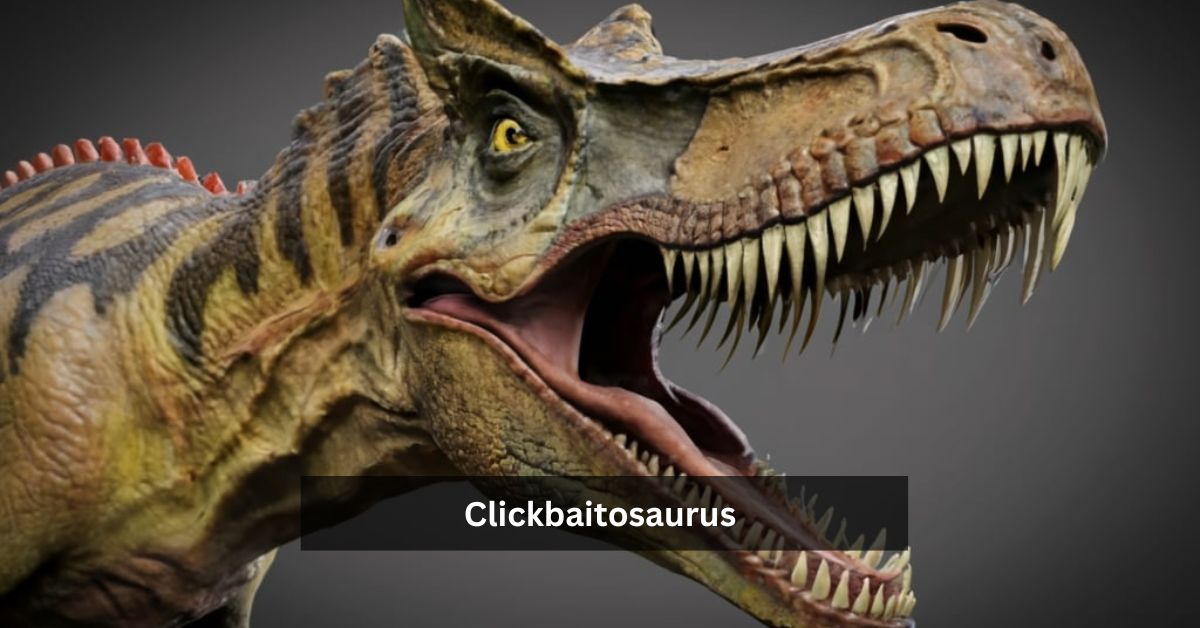Clickbaitosaurus – Understanding the Psychology Behind Clickbait and Its Impact on Modern Media
In today’s fast-paced digital world, where attention spans are shorter than ever, grabbing someone’s interest can be a challenging task. This is where the concept of “Clickbaitosaurus” comes into play. The term “Clickbaitosaurus” is an intriguing metaphor that highlights the intricate relationship between human psychology, marketing strategies, and the evolution of digital content. To understand this concept fully, we need to delve into the nature of clickbait, its impact on modern media, and the psychological principles that make it so effective.
The Evolution of Clickbait
Clickbait has evolved significantly since the early days of the internet. Initially, it was a simple tactic used by marketers to lure readers into clicking on links by using sensationalized headlines and misleading thumbnails. The goal was to drive traffic to websites, often at the expense of content quality. Over time, however, clickbait has become more sophisticated, evolving into a powerful tool that taps into human psychology to capture attention and drive engagement.
The term “Clickbaitosaurus” is a playful representation of this evolution, likening the practice to a prehistoric creature that has adapted over time to survive in a changing environment. Just as dinosaurs evolved to fit their surroundings, clickbait has adapted to the ever-changing digital landscape, becoming more nuanced and effective in the process.
The Psychology Behind Clickbaitosaurus
At its core, clickbait leverages fundamental aspects of human psychology to achieve its goals. Here are some key psychological principles that make clickbait so effective:
Curiosity Gap
One of the most powerful psychological triggers used in clickbait is the “curiosity gap,” a concept that exploits the gap between what people know and what they want to know. Headlines that hint at information but do not provide the full story compel readers to click to satisfy their curiosity.
FOMO (Fear of Missing Out)
Another tactic is tapping into the fear of missing out (FOMO). By suggesting that the content is exclusive, urgent, or contains information that others might not have, clickbait creates a sense of urgency that prompts immediate action.
Emotional Triggers
Clickbait often appeals to emotions like anger, joy, sadness, or surprise. Emotional content is more likely to be shared and discussed, increasing its reach and impact.
Social Proof
Humans are social creatures who are influenced by the actions of others. Clickbait headlines often imply that many others are already engaged with the content, creating a bandwagon effect where people click because they don’t want to be left out.
Clickbaitosaurus in Modern Media
The Clickbaitosaurus has found a thriving environment in modern media, where competition for attention is fierce and the monetization of content is directly tied to engagement metrics. Here are some areas where the Clickbaitosaurus has had a significant impact:
1. News Outlets
Traditional news outlets have increasingly adopted clickbait tactics to compete with digital-first competitors. Sensational headlines and emotionally charged content can drive significant traffic, but this often comes at the cost of journalistic integrity. The need for clicks can sometimes lead to misleading headlines that misrepresent the actual content, damaging public trust in media.
2. Social Media Platforms
Social media has amplified the reach and impact of clickbait. Algorithms designed to maximize engagement often prioritize sensational and emotionally charged content, which tends to be clickbait. This creates a feedback loop where clickbait content is more likely to be seen, clicked on, and shared, further entrenching its presence on these platforms.
3. Entertainment and Pop Culture
In the realm of entertainment, clickbait is used to generate buzz and drive engagement. Whether it’s celebrity gossip, movie rumors, or reality TV scandals, clickbait headlines play a crucial role in keeping audiences hooked and invested in the latest developments.
4. E-commerce and Marketing
E-commerce and digital marketing heavily rely on clickbait strategies to drive sales. From product launches to promotional campaigns, creating a sense of urgency and exclusivity is key to driving conversions. Clickbait tactics are often used to create compelling narratives around products, encouraging consumers to click, learn more, and ultimately make a purchase.
The Ethical Implications of Clickbaitosaurus
While the Clickbaitosaurus has proven to be a powerful tool for capturing attention and driving engagement, it also raises significant ethical concerns. The use of misleading headlines and sensationalized content can have a range of negative consequences:
1. Misinformation and Fake News
Clickbait can contribute to the spread of misinformation and fake news. When headlines are misleading or sensationalized, they can distort the truth and mislead readers. This is particularly concerning in the context of news and information, where accuracy and credibility are paramount.
2. Erosion of Trust
Over time, the use of clickbait can erode trust in media and content creators. When audiences feel manipulated or deceived by clickbait tactics, they may become skeptical of the content they consume, leading to a general decline in trust and credibility.
3. Impact on Mental Health
The emotional manipulation inherent in clickbait can also have negative effects on mental health. Constant exposure to sensationalized and emotionally charged content can contribute to anxiety, stress, and a distorted perception of reality.
How to Identify and Avoid Clickbaitosaurus?
Given the prevalence of clickbait, it’s important for readers to be able to identify and avoid it. Here are some tips for spotting clickbait and making informed choices about the content you consume:
Look Beyond the Headline
Don’t be swayed by sensational headlines alone. Take a moment to consider whether the content is likely to deliver on the promises made in the headline.
Check the Source
Consider the credibility of the source. Reputable news outlets and content creators are less likely to use misleading clickbait tactics.
Read Critically
Approach content with a critical eye. If something seems too sensational or emotionally charged, it may be worth questioning its accuracy and intent.
Seek Out Reliable Information
Whenever possible, seek out reliable and credible sources of information. This can help ensure that you’re getting accurate and trustworthy content.
The Future of Clickbaitosaurus
As digital media continues to evolve, so too will the tactics and strategies associated with clickbait. The Clickbaitosaurus is likely to become even more sophisticated, leveraging new technologies like artificial intelligence and machine learning to create more personalized and targeted content. At the same time, there is a growing awareness of the ethical implications of clickbait, which may lead to increased regulation and oversight in the future.
While the Clickbaitosaurus is here to stay, it’s important for both content creators and consumers to be aware of its impact and make informed choices about the content they produce and consume. By understanding the psychology behind clickbait and recognizing its effects, we can navigate the digital landscape more effectively and make more informed decisions about the media we engage with.
FAQs
1.How does Clickbaitosaurus affect modern media?
Clickbaitosaurus affects modern media by driving traffic and engagement through sensationalized headlines and emotionally charged content, often at the expense of quality and accuracy.
2. Why is clickbait so effective?
Clickbait is effective because it taps into fundamental aspects of human psychology, such as curiosity, fear of missing out, emotional triggers, and social proof, to capture attention and drive engagement.
3. What are the ethical concerns surrounding Clickbaitosaurus?
The ethical concerns surrounding Clickbaitosaurus include the spread of misinformation, erosion of trust in media, and potential negative effects on mental health due to emotional manipulation.
Conclusion
The “Clickbaitosaurus” metaphor effectively illustrates the evolution of clickbait in digital media, highlighting its reliance on psychological triggers to capture attention. While clickbait can drive engagement, it often raises ethical concerns, such as spreading misinformation and eroding public trust. As digital content continues to evolve, there’s a growing need for a more ethical approach that prioritizes accuracy and quality. Both content creators and consumers must be aware of these challenges and work towards a responsible digital environment. By doing so, we can balance the need for engagement with the importance of truthfulness and integrity. The future of clickbait lies in maintaining this balance, ensuring it serves the audience’s best interests.







